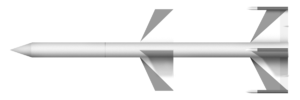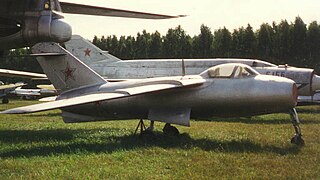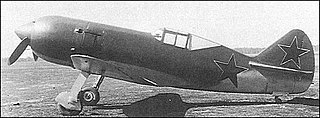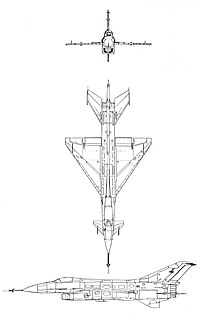| Raduga K-9 | |
|---|---|
 K-9 prototype missile | |
| Type | short-range air-to-air missile |
| Place of origin | Soviet Union |
| Production history | |
| Manufacturer | Raduga |
| Specifications | |
| Mass | 245 kg (540 lb) |
| Length | 4.5 m (14 ft 9 in) |
| Diameter | 250 mm (9.8 in) |
| Warhead | 27 kg (60 lb) |
| Engine | two-stage solid-fuel rocket engine |
| Wingspan | 1.6 m (5 ft 3 in) |
Operational range | 9 km (5.6 mi) |
| Speed | 5,040 km/h (3,130 mph) |
Guidance system | SARH |
| Accuracy | no more than 55% |
Launch platform | Mikoyan-Gurevich Ye-152A |
The Raduga K-9 (NATO reporting name AA-4 'Awl') was a short-range air-to-air missile developed by the Soviet Union in the late 1950s. It was designed by MKB Raduga, a division of aircraft maker Mikoyan-Gurevich. The K-9 was also known as the K-155, and would apparently have had the service designation R-38. It was intended to arm the Mikoyan-Gurevich Ye-152A (NATO reporting name 'Flipper'), an experimental high speed twin-engine aircraft, predecessor to the Mikoyan-Gurevich MiG-25 'Foxbat'. When the Ye-152A was shown at Tushino in 1961, a prototype of the K-9 missile was displayed with it. [1]
NATO reporting names are code names for military equipment from Russia, China, and historically, the Eastern Bloc. They provide unambiguous and easily understood English words in a uniform manner in place of the original designations, which either may have been unknown to the Western world at the time or easily confused codes. For example, the Russian bomber jet Tupolev Tu-160 is simply called "Blackjack".

An air-to-air missile (AAM) is a missile fired from an aircraft for the purpose of destroying another aircraft. AAMs are typically powered by one or more rocket motors, usually solid fueled but sometimes liquid fueled. Ramjet engines, as used on the Meteor (missile) are emerging as propulsion that will enable future medium-range missiles to maintain higher average speed across their engagement envelope.

The Soviet Union, officially the Union of Soviet Socialist Republics (USSR), was a Marxist-Leninist sovereign state in Eurasia that existed from 1922 to 1991. Nominally a union of multiple national Soviet republics, its government and economy were highly centralized. The country was a one-party state, governed by the Communist Party with Moscow as its capital in its largest republic, the Russian Soviet Federative Socialist Republic. Other major urban centres were Leningrad, Kiev, Minsk, Tashkent, Alma-Ata, and Novosibirsk. It spanned over 10,000 kilometres (6,200 mi) east to west across 11 time zones, and over 7,200 kilometres (4,500 mi) north to south. It had five climate zones: tundra, taiga, steppes, desert and mountains.
Neither the 'Flipper' nor the 'Awl' ever entered production. [2]












